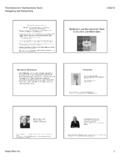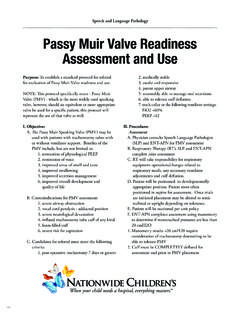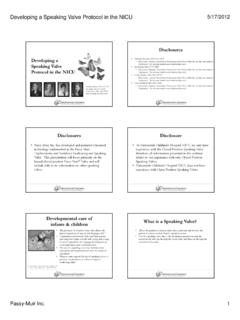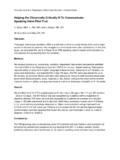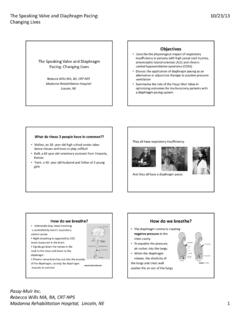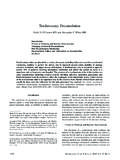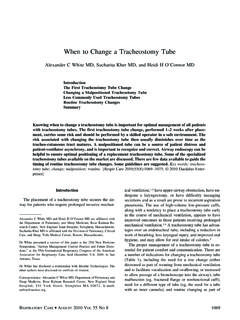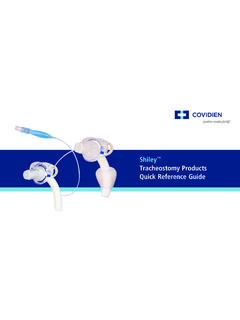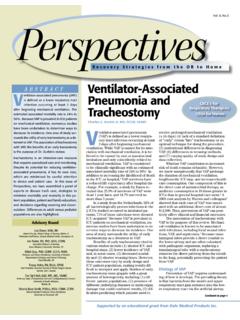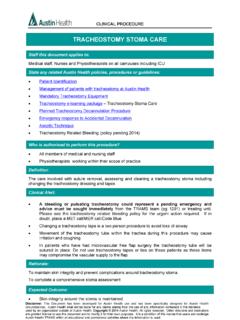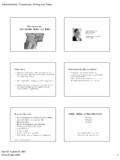Transcription of Costs Facts about Tracheostomy and Mechanical …
1 Costs Facts about Tracheostomy and Mechanical ventilation : Tracheostomy is one of the most frequent procedures performed in an intensive care unit 1,2 100,000 Average number of tracheostomies performed annually in the 1 24% Percentage of tracheostomies performed on critically ill patients that require Mechanical ventilation 3 Patients who require Tracheostomy for respiratory failure, diagnosis-related group (DRG) 483, have a high consumption of resources. By DRG categories, they have the highest patient Costs and the highest hospital 29 days Average length of stay for a tracheostomized patient 5 $265,499 Average amount of hospital charges associated with Tracheostomy 5 $60 Billion Expected national bill in the year 2020 associated with prolonged Mechanical ventilation 6 References: 1.
2 Yu, M. 2010. Tracheostomy patients on the ward: multiplebenefits from a multidisciplinary team? Critical Care, 14:109T 2. Muralidhar, K. 2008. Tracheostomy in ICU: An Insight into the Present Concepts. Indian Journal of Anaesthesia. 52 (1): 28-37. 3. Esteban, A. et al. 2000. How is Mechanical ventilation employed in the intensive care unit? An international utilization review. American Journal of Respiratory Critical Care Medicine. 161:1450-1458 4. Engoren, M. et. al. 2004. Hospital and Long-term Outcome after Tracheostomy for Respiratory Failure. Chest. 125:220-227. 5. 2009, Agency for Healthcare Research and Quality (AHRQ), HCUP-netNational and regional estimates on hospital use for all patients from the HCUP Nationwide Inpatient Sample (NIS) 6.
3 Zilberberg, M. & Shorr, A. 2008. Prolonged acute Mechanical ventilation and hospital bed utilization in 2020 in the United States: implications for budgets, plant and personnel planning. BMC Health Services Research,8:242. CHEST January 2004 vol. 125 no. 1 220-227 Passy-MuirInc. Hospital and Long-term Outcome After Tracheostomy for Respiratory Failure Engoren M, Arslanian-Engoren C, Fenn-Buderer N. Departments of Anesthesiology and Internal Medicine, St. Vincent Mercy Medical Center, Toledo, OH 43608, USA. Objective: To determine the patient characteristics, hospital course, hospital cost, posthospital survival, and functional outcome in a group of patients with Tracheostomy for respiratory failure. Design: Retrospective chart review combined with prospective evaluation of functional status.
4 Setting: An urban, tertiary-care medical center. Patients: Adult patients with Tracheostomy for respiratory failure between January 1, 1998, and December 31, 2000. Methods: Retrospective chart review and prospective administration of the Short Form-36 (SF-36) for health status outcome. Results: Four hundred twenty-nine patients were studied. Hospital mortality was 19%. Only 57% of survivors were liberated from Mechanical ventilation . At 100 days, 6 months, 1 year, and 2 years after discharge, 24%, 30%, 36%, and 42% of hospital survivors had died, respectively. Patients liberated from Mechanical ventilation and having their Tracheostomy tubes decannulated had the lowest mortality (8% at 1 year); the mortality of ventilator-dependent patients was highest (57%).
5 Sixty-six patients completed the SF-36 for functional status. While emotional health was generally good, physical function was quite limited. Median hospital direct variable cost was $29,340. Conclusion: Overall survival and functional status are poor in patients with Tracheostomy for respiratory failure. Patients who are liberated from Mechanical ventilation and have their Tracheostomy tubes removed have the best survival; however, it comes at a higher hospital cost and longer length of stay. American Journal of Respiratory and Critical Care Medicine 2000 May;161(5):1450-8. How is Mechanical ventilation employed in the intensive care unit? An international utilization review. Esteban A, Anzueto A, Al a I, Gordo F, Apeztegu a C, P lizas F, Cide D, Goldwaser R, Soto L, Bugedo G, Rodrigo C, Pimentel J, Raimondi G, Tobin MJ.
6 Hospital Universitario de Getafe, Madrid, Spain. Abstract: A 1-d point-prevalence study was performed with the aim of describing the characteristics of conventional Mechanical ventilation in intensive care units ICUs from North America, South America, Spain, and Portugal. The study involved 412 medical-surgical ICUs and 1,638 patients receiving Mechanical ventilation at the moment of the study. The main outcome measures were characterization of the indications for initiation of Mechanical ventilation , the artificial airways used to deliver Mechanical ventilation , the ventilator modes and settings, and the methods of weaning. The median age of the study patients was 61 yr, and the median duration of Mechanical ventilation at the time of the study was 7 d.
7 Common indications for the initiation of Mechanical ventilation included acute respiratory failure (66%), acute exacerbation of chronic obstructive pulmonary disease (13%), coma (10%), and neuromuscular disorders (10%). Mechanical ventilation was delivered via an endotracheal tube in 75% of patients, a Tracheostomy in 24%, and a facial mask in 1%. Ventilator modes consisted of assist/control ventilation in 47% of patients and 46% were ventilated with synchronized intermittent mandatory ventilation , pressure support, or the combination of both. The median tidal volume setting was 9 ml/kg in patients receiving assist/control and the median setting of pressure support was 18 cm H(2)O. Positive end-expiratory pressure was not employed in 31% of patients.
8 Method of weaning varied considerably from country to country, and even within a country several methods were in use. We conclude that the primary indications for Mechanical ventilation and the ventilator settings were remarkably similar across countries, but the selection of modes of Mechanical ventilation and methods of weaning varied considerably from country to country. BMC Health Services Research 2008, 8:242 Prolonged acute Mechanical ventilation and hospital bed utilization in 2020 in the United States: implications for budgets, plant and personnel planning Marya D Zilberberg1,2, and Andrew F Shorr3 1. School of Public Health and Health Sciences, University of Massachusetts, Amherst, MA, USA 2. Evi Med Research Group, LLC, Goshen, MA, USA 3.
9 Division of Pulmonary and Critical Care, Washington Hospital Center, Washington, DC, USA Background: Adult patients on prolonged acute Mechanical ventilation (PAMV) comprise 1/3 of all adult MV patients, consume 2/3 of hospital resources allocated to MV population, and are nearly twice as likely to require a discharge to a skilled nursing facility (SNF). Their numbers are projected to double by year 2020. To aid in planning for this growth, we projected their annualized days and Costs of hospital use and SNF discharges in year 2020 in the US. Methods: We constructed a model estimating the relevant components of hospital utilization. We computed the total days and Costs for each component; we also applied the risk for SNF discharge to the total 2020 PAMV population.
10 The underlying assumption was that process of care does not change over the time horizon. We performed Monte Carlo simulations to establish 95% confidence intervals (CI) for the point estimates. Results: Given 2020 projected PAMV volume of 605,898 cases, they will require (95% CI ) million MV, (95% CI ) million ICU and (95% CI ) million hospital days, representing an absolute increase of million MV, million ICU and million hospital days over year 2000, at a total inflation-adjusted cost of over $64 billion. Expected discharges to SNF are 218,123 (95% CI 177,268 266,739), compared to 90,928 in 2000. Conclusion: Our model suggest that the projected growth in the US in PAMV population by 2020 will result in annualized increases of more than 2, 3, and 6 million MV, ICU and hospital days, respectively, over year 2000.

